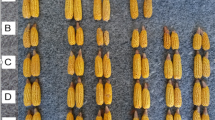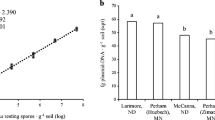Abstract
A broadcast application of PCNB (Terraclor) resulted in a reasonably uniform distribution of the chemical in the soil with the concentration decreasing in a linear fashion with increasing depth in the soil profile.
A banded application resuluted in a considerably higher chemical concentration at the 4–6 inch depth than at the 0–2 or the 2–4 inch depths. The problem of the lack of uniformity of chemical distribution could probably be solved by altering nozzle placement and size and allow use of the band method of application to minimize grower cost. More complete disking in the case of the broadcast treatment would probably result in a relatively uniform distribution of the chemical but at higher cost to the grower.
PCNB application rates of 10, 15 and 25 lbs per acre broadcast and 71/2, 10 and 121/2 lbs per acre in a band significantly reduced the severity ofRhizoctonia infection of Russet Burbank potatoes but did not increase potato yields significantly.
Resumen
Una aplicación al voleo (broadcast) de PCNB (Terraclor) resultó en una rasonable distribució uniforme en el suelo, en el cual la concentración del PCNB descendía en forma lineal con el incremento de la profundidad en el perfil del suelo.
Una aplicación en bandas, resultó en una considerable más alta concentración a la profundidad de 4–6 pulgadas que a 0–2 o 2–4 pulgadas. El problema de la falta de uniformidad en la distribución del producto químino pordía ser corregida regulando el rociador o por el tamaño de este, lo que permitiría el uso de este método, disminuyendo asi el costo de aplicación.
Una mezcla más completa, en el caso de aplicación al voleo, podría ressultar en una relativa distribución uniforme del producto químico, pero a costo mayor para el agricultor.
Aplicaciones de PCNB a dosis de 10, 15 y 25 libras por acre usando el métode de voleo y 71/2, 10 y 121/2 libras por acre en bandas, reduce significativamente la severidad de infección de Rhizoctonia en los tuberculos de la variedad Russet Burbank, pero no hubo incremento del rendimiento en forma significativa.
Similar content being viewed by others
Literature Cited
Horsfall, J. G. and R. W. Barratt. 1945. An improved grading system for measuring plant diseases. (Abstr.) Phytopathology 35: 655.
Livingston, C. H., N. Oshima and M. D. Harrison. 1964. Terraclor as a control for various levels ofRhizoctonia inoculum in potato soils. American Potato J. 41: 239–243.
van Emden, J. H. 1958. Control ofRhizoctonia solani (Kuhn) in potatoes by disinfection of seed tubers and by chemical treatment of the soil. European Potato J. 1: 52.
Author information
Authors and Affiliations
Additional information
Published with the approval of the Director, Colorado Agricultural Experiment Station as Scientific Journal Series No. 1492.
Rights and permissions
About this article
Cite this article
Harrison, M.D., Johnson, G. & Barmington, R.D. Comparison of two methods of PCNB application for control of Rhizoctonia infection of potatoes. American Potato Journal 47, 386–393 (1970). https://doi.org/10.1007/BF02864747
Accepted:
Issue Date:
DOI: https://doi.org/10.1007/BF02864747




